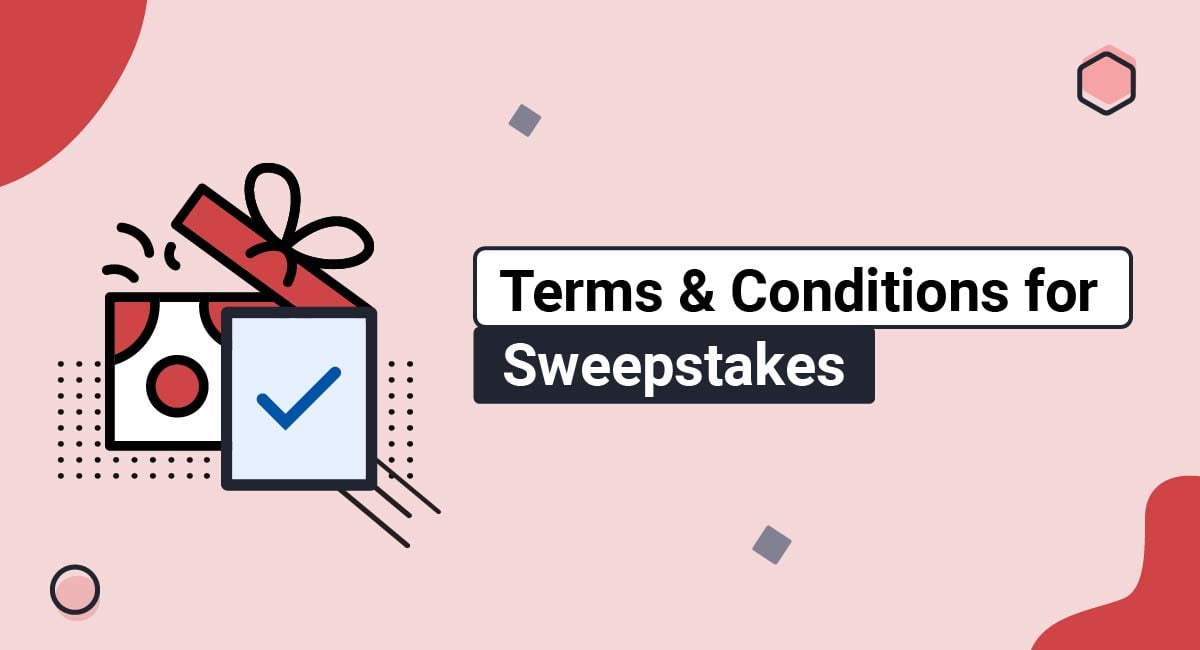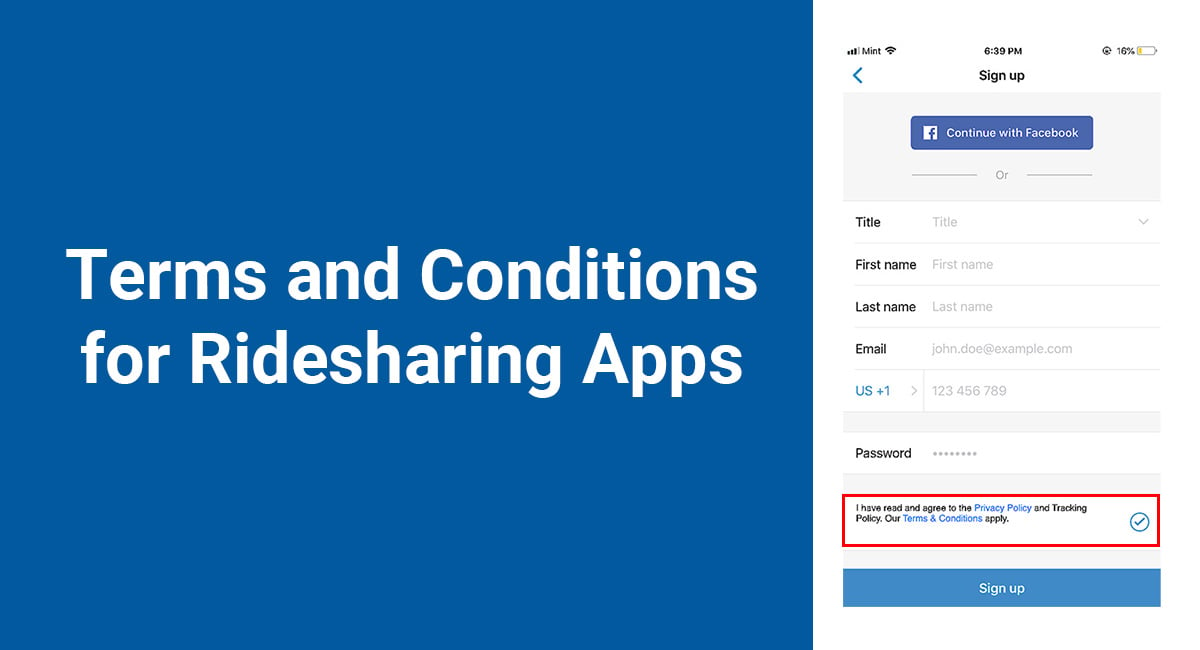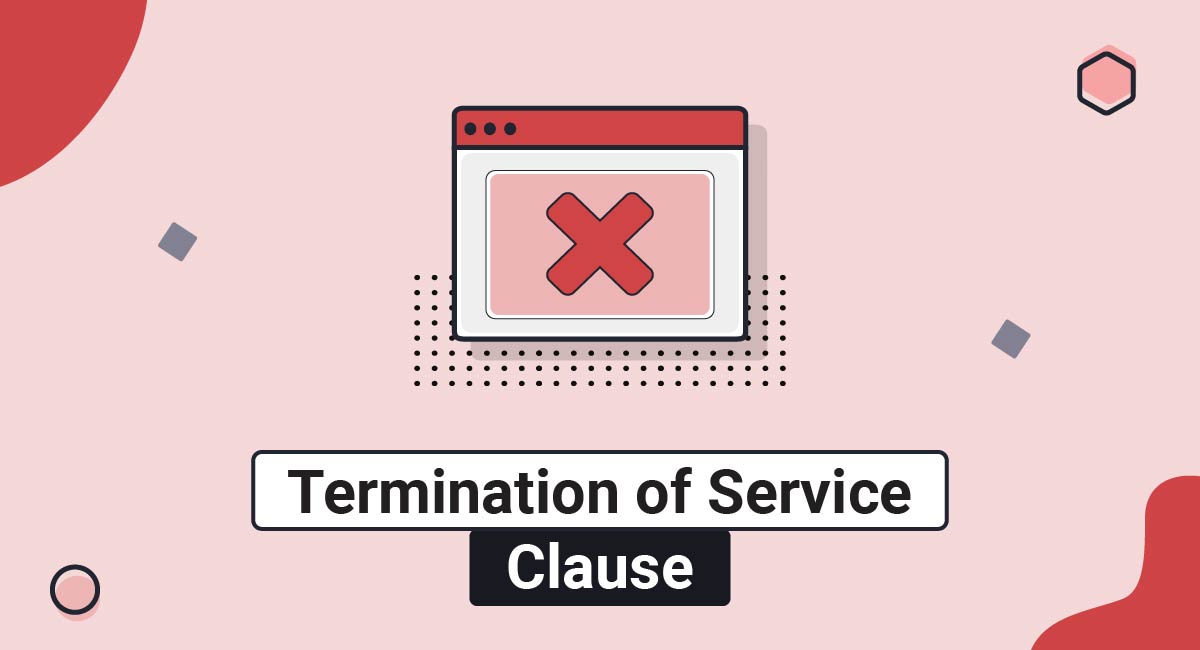If your promotions fall under the sweepstakes category, you'll want to draft a specialized Terms and Conditions agreement.
Companies frequently face trouble with the Federal Trade Commission (FTC) when they are not upfront or they make large unattainable promises.
This article will explain what the legal requirements are around sweepstakes, and how to create a custom Terms agreement for yours.
Our Terms and Conditions Generator makes it easy to create a Terms and Conditions agreement for your business. Just follow these steps:
-
At Step 1, select the Website option or the App option or both.
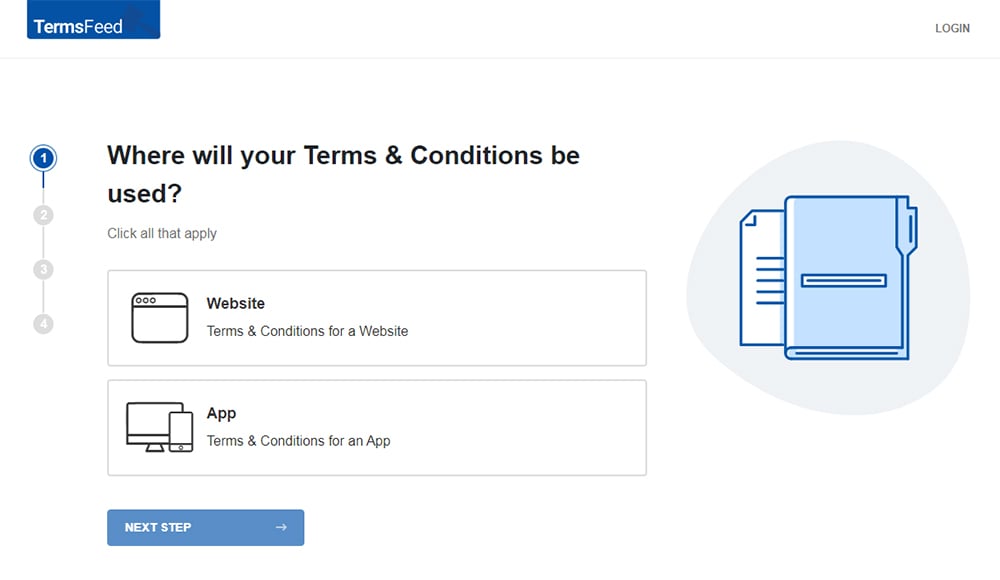
-
Answer some questions about your website or app.
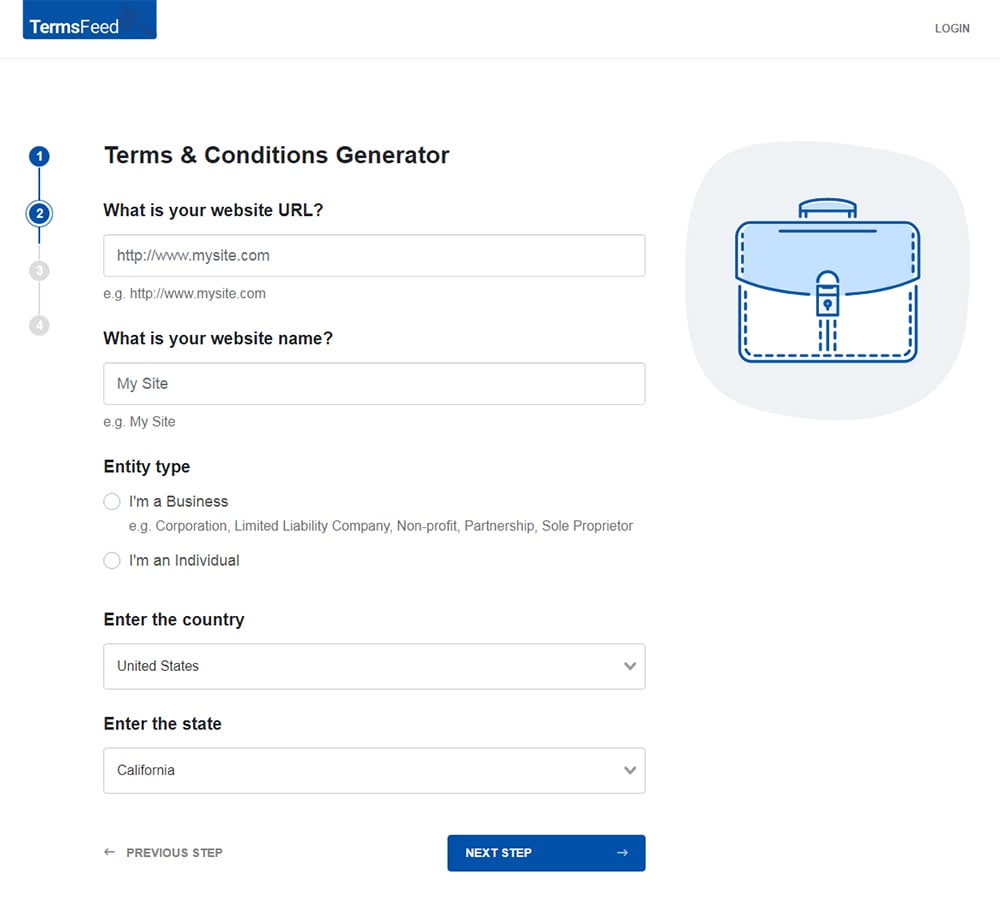
-
Answer some questions about your business.
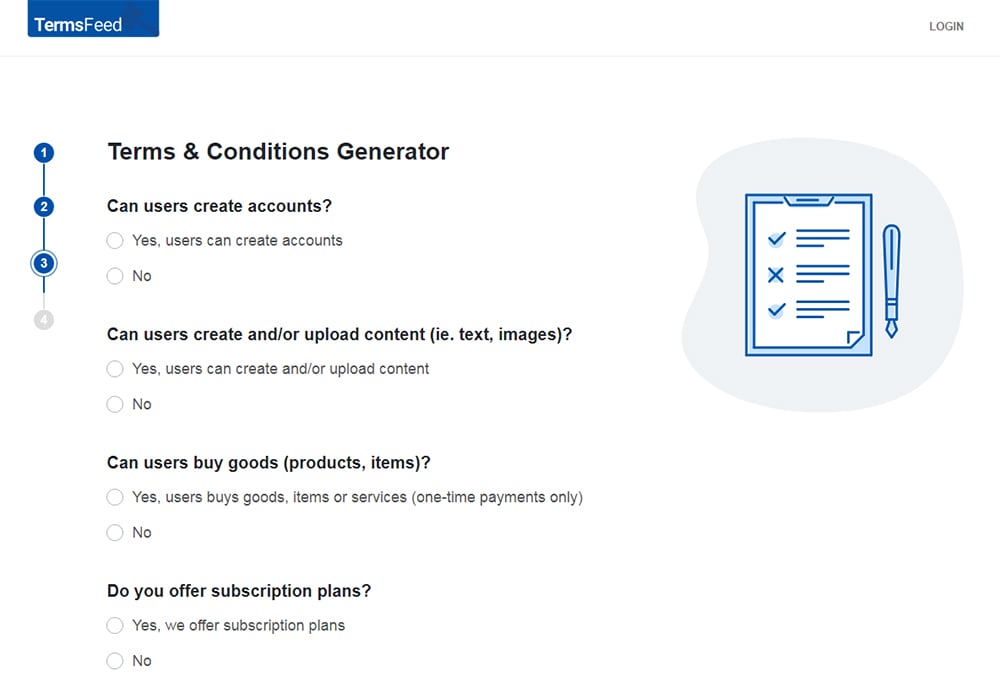
-
Enter the email address where you'd like the T&C delivered and click "Generate."
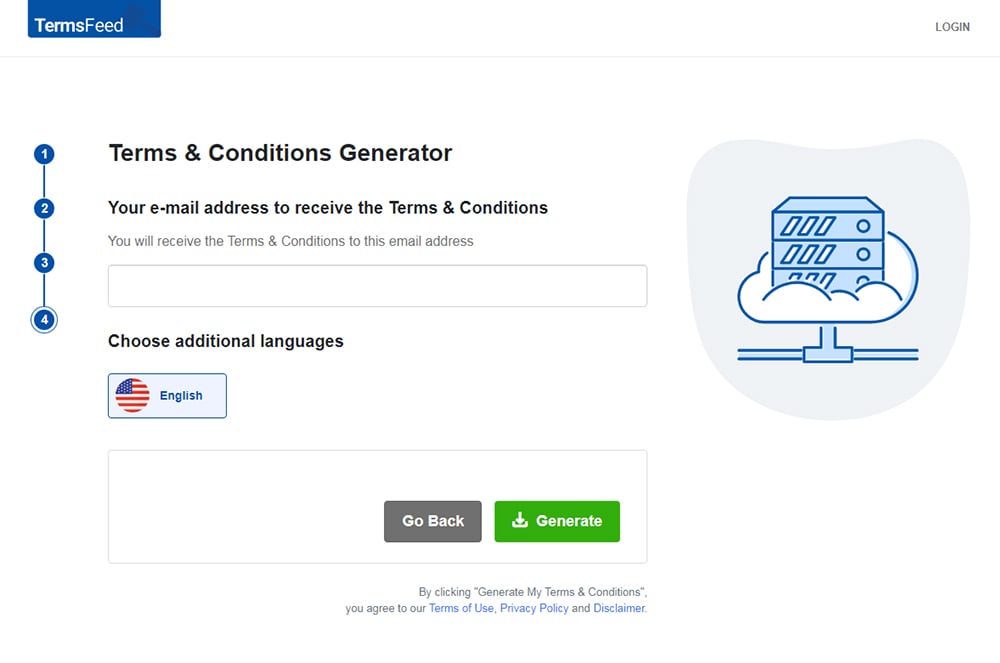
You'll be able to instantly access and download the Terms & Conditions agreement.
- 1. What are Sweepstakes?
- 2. What are the FTC's Rules on Sweepstakes?
- 2.1. No Required Payments
- 2.2. Advertise With Caution
- 3. How to Create a Terms and Conditions for Sweepstakes
- 3.1. "No Purchase Necessary to Win"
- 3.2. How to Enter the Sweepstakes
- 3.3. Entry Participation Limits
- 3.4. Closing Dates or Deadlines
- 3.5. Notification of a Winner
- 3.6. Sponsor Identification
- 3.7. Odds of Winning
- 3.8. The Process for Selecting Winners
- 3.9. Tax Responsibility
- 4. Where to Display Your Terms Agreement
- 5. Summary
What are Sweepstakes?
Sweepstakes are a promotion effort where a winner (or winners) receives a prize. Participants enter the contest by performing a small task such as sharing social media posts or filling out forms on websites. Before the Internet, these efforts occurred through paper forms and through the mail.
While sweepstakes are legal, lotteries by private entities are not. In the U.S., lotteries must be regulated and managed by state lottery commissions.
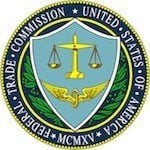
The FTC worked with the Federal Communications Commission (FCC) to regulate sweepstakes and lotteries and the way companies communicate about sweepstakes.
According to these rules, a lottery has three elements:
- Chance
- A prize, and
- Payment by the participant
The payment element is the main factor that turns a fun contest into a lottery.
Sweepstakes take a different approach by not requiring a payment or purchase to enter.
It's easy to find examples because these efforts are common.

In the U.S., Publishers Clearing House is a long time favorite having started off with entries through the mail and now promotes its contest online.
The information it collects from people who enter the contest is used to help other companies advertise but their sweepstakes does not require any payments from customers. Consumers enter the contest by clicking this advertisement on the Publisher's Clearing House website:
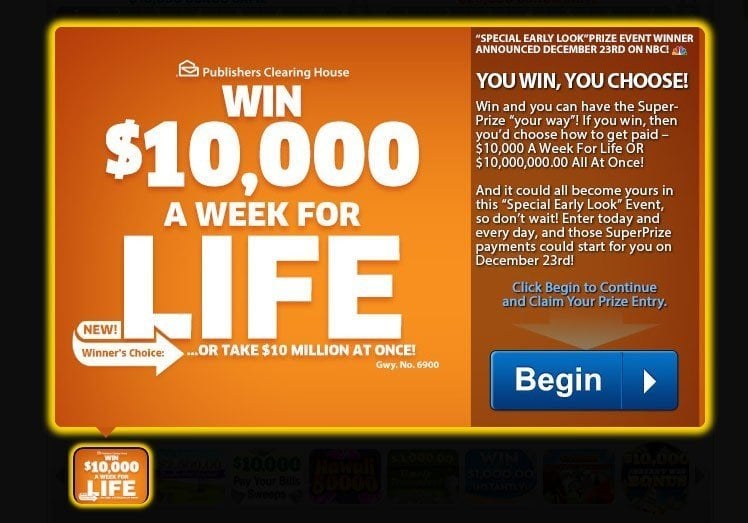
Many companies take advantage of social media and the participation it inspires.

Corsair, a leader in high-performing computer hardware, runs frequent sweepstakes on its Facebook and Twitter pages.
They require customers or potential customers to like their pages or retweet items in order to enter these contests. In these examples of their promotions, there's no requirement to purchase but only to participate through social media or visit a website and provide personal information.
This is from their Twitter feed, which gives a link to an entry form on their website:
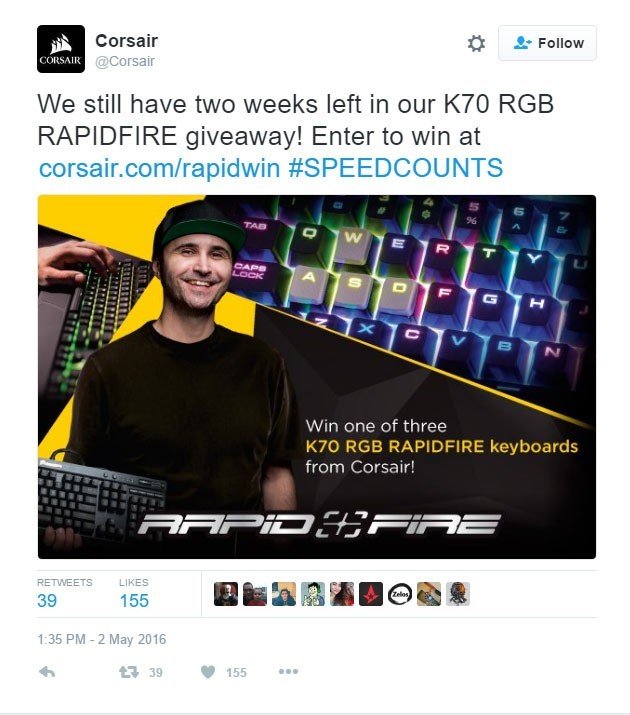
A Facebook post from Corsair only requires liking the post and their page:
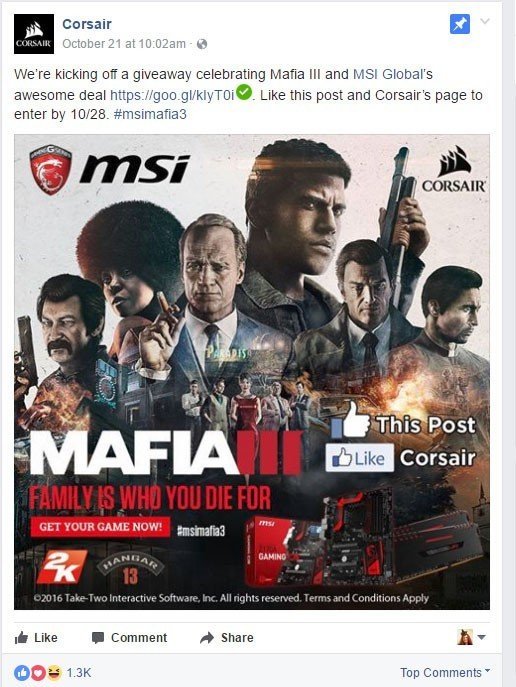
The purpose with the Corsair examples of these sweepstakes is engagement and adding more followers.
What are the FTC's Rules on Sweepstakes?
The FTC is concerned about consumers being mislead. In a series of regulations and rulings, it offers recommendations when conducting sweepstakes.
No Required Payments
The lack of payment is an obvious element that separates sweepstakes from a lottery or worse, a fake prize scheme. Unfortunately, fraudulent marketing efforts still arise.
In September 2016, the FTC uncovered a prize scheme that mailed false notifications to consumers and informed them that they won $1 million or more. To collect the prize, they needed to pay a $25 "processing fee" which was mailed to a post office box in the Netherlands.
Once the consumer fell for this scheme, their personal information was shared with similar entities who would continue pursuing people for money and information. The FTC voted to approve this complaint so consumers could pursue damages.
While the mailings included boilerplate language that the prize was not actually won, it was considered ambiguous and misleading.
The FTC made its decision based on the lack of notification to consumers but also the requirement of payment.
Generally, if you plan on running sweepstakes as a promotion effort, do not require a payment.
Advertise With Caution
Like any mass-distributed information, social media advertising can also be misleading.
First, make it obvious that it is an advertisement.
If your Twitter, Instagram or Facebook starts with "Ad" or "#Ad", that is likely adequate. There are other labels that work including "#contest" or "#sweepstakes".
This offers the transparency the FTC likes to see for transparent communication.
Second, be careful of how you allow consumers to promote your sweepstakes.
If there's any compensation or additional sweepstakes entries that result from sharing, liking or getting other people to sign up, that needs to be in your announcement.
Using the "#sweepstakes" seems to meet this requirement too, however, the FTC made it clear that just using the shortened "#sweeps" is not sufficient.
![]()
This is an example from Chase on its Twitter page of how to use this hashtag:
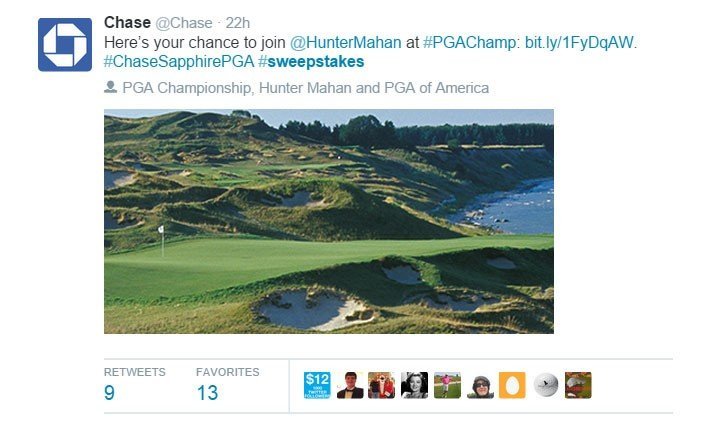
Looking at the Corsair examples above, there is clear language that there is a sweepstake but no "#contest" type of hashtag.
Other entities also prefer to use language rather than a hashtag to make the contest format clear. This one is an example of a retweet from Ragu as a means of entering a contest:

Do not assume that "contest-like" language is enough when you are promoting sweepstakes. Use a hashtag or in the least, the words "sweepstakes" or "contest."
How to Create a Terms and Conditions for Sweepstakes
These elements assure the legality of your contest and offer clarity. When you draft your sweepstakes Terms and Conditions (also known as Terms of Use or Terms of Service), it must contain at least these clauses.
"No Purchase Necessary to Win"
The rules of sweepstakes must make this statement clearly.
Most Terms and Conditions agreements for sweepstakes place this at the top and often in all-capital letters.
There's a good reason why companies make that choice: any inference of a payment or purchase requirement to enter the contest can lead to problems with the FTC.
Here's an example of this:

Here's another example, showing how this statement can be posted at the immediate top of the Terms agreement:

Some companies may include more coverage in this statement if there is a risk that even an expense can be construed as a purchase.
Priceline ran a Summer Road Trip Sweepstakes to give away a MINI Cooper S Roadster. Since users could receive text messages regarding the contest and Priceline promotions, Priceline added the possibility of extra expenses in its agreement while indicating that this would not increase chances of winning:

While you definitely want to address the "No purchase" requirement, also include any elements that could suggest that participants can increase their chances of winning by spending money.
That would include expenses like text messaging fees and anything else that might lead to purchasing products not associated with the sweepstakes.
How to Enter the Sweepstakes
Making the entry procedures clear to participants is also important. Usually they can be pretty broad, such as seen here:

The Priceline entry rules are more detailed. This is likely due to the fact that entering that contest involved filling out an online form. In order to make this even clearer, it describes that process in its sweepstakes Terms and Conditions:

Here's a more simple example describing one aspect of entry:

Entry Participation Limits
Many companies want to limit sweepstakes participation.
This reduces liability issues and also helps companies avoid the complexities that may be involved offering prizes in some jurisdictions.
Amazon also limits contest participation by age and geographic area. It makes this clear in one short paragraph:
![]()
Priceline limits on age and whether the entry is complete. It places other limits on entry too in this section of its sweepstakes T&C:

If you have limits regarding geography, age or how to enter, place these together on your sweepstakes Terms and Conditions.
Closing Dates or Deadlines
Deadlines should also be clear. It is common for smaller sweepstakes to be ongoing, but for larger prizes, there's often a set time when the promotion ends.
Priceline offered a range of dates when it ran its Summer Road Trip promotion in 2014:
![]()
Amazon refers back to the specific promotion, which makes it clear all deadlines are presented in its social media announcements:
![]()
The approach you take depends on how you plan to run the sweepstakes.
Notification of a Winner
It's likely you already explain how winners are notified in your sweepstakes. Much like the sweepstakes period, this will depend on how you run contests.
Specific limited sweepstakes with one prize are handled differently than continuing efforts.
Priceline, with its prize of one car, is very specific with winner notification:

Amazon refers back to its promotion but promises notification within five days of the conclusion of the contest:
![]()
Corsair takes the same approach as Amazon but also indicates that a failure to claim the prize results in an alternate winner being chosen:

Sponsor Identification
The sponsor identification paragraph includes the name and address of the sponsor. You can see this with the Corsair agreement:

Sponsor identification is another move towards transparency.
Since many promotion schemes involve dense entities that are not always forthcoming with their location, you can display your legitimacy by providing your company name and address along with any corporate registration information.
Odds of Winning
Stating the odds of winning is also an advantage in transparency.
As the FTC actions show, making promises that cannot be kept will not work in your favor. Never tell a consumer that they won something when in reality, they did not, and do not state the odds of winning as higher than they are in reality.
In the bold print by Priceline, it explains that the odds of winning depend on the number of entries. This is an honest statement that does not make bold promises.
It's clear from anyone entering this contest that there is no guarantee of winning this car:

This is the most common way of presenting odds.
Older promotions gave numbers, like one in 100,000 chance of winning, but this does not seem as acceptable anymore. You are likely in a safe zone legally if you simply state "Odds of winning a prize dependent on the number of entries received."
The Process for Selecting Winners
If you are choosing winners randomly from Facebook likes or Twitter retweets, make that clear.
Also be clear if, like Priceline, you are holding a drawing in a controlled location:
![]()
Along with the process, also include any requirements for accepting the prize. For example, winners may have to execute an affidavit of eligibility or a publicity release, if that is permitted in their jurisdiction.
Make the winners list available. Include a website link or email address where users can request that list.
Tax Responsibility
When you are giving away a large prize, it is likely taxable as income. Note that the winner is responsible for any taxes in a clause like this:

Where to Display Your Terms Agreement
Display your Terms agreement along with other important links, such as in your website footer. This will ensure that everyone who goes to your website to sign up for your sweepstakes has a chance to easily and quickly view your agreement.
Here's an example of this:
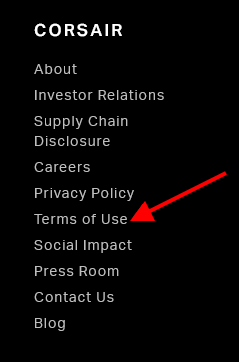
Summary
If you run sweepstakes, make sure to have a Terms and Conditions agreement that includes specific clauses regarding sweepstakes details.
Some of these clauses should address things like how to enter the sweepstakes, the fact that no payment is required to enter, how and when a winner will be chosen, and who is responsible for paying any taxes or fees as a result of winning the sweepstakes.
Display your Terms and Conditions link within your website's footer so that sweepstakes participants can access it easily from any page on your website.

Comprehensive compliance starts with a Privacy Policy.
Comply with the law with our agreements, policies, and consent banners. Everything is included.
